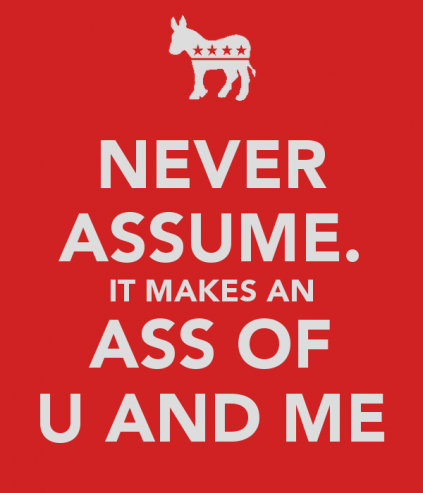
Felix, from The Odd Couple, got it right:
Never assume otherwise you will make an ASS out of U and ME.
An assumption is a conclusion that one makes based on no or little information. Some assumptions might be correct, but unless you can somehow verify or collaborate what you are assuming, then there is always a risk that you will be wrong. How wrong you might be and the impact of an incorrect assumption is all tied into your risk appetite.
The more a risk is managed, the lower the risk appetite required to take it on. The less risk there is then almost always the safer a decision is and the return is proportionally lower.
Risk matrixes, risk appetite, risk analysis etc are complex concepts and whole industries have evolved to teach the principles of risk management or to plot risk exposure. Stay tuned for a quick 400 to 800 work explanation soon.
In the meantime, let’s look at ASSUMPTIONS.
As already mentioned, an assumption is a conclusion made with little or no information. The process that we use in reaching this conclusion is largely based on our own firsthand experience, however, it could also include inputs from family, colleagues, media; It is built from our total exposure points.
In business we also need to throw in a portion of Return On Investment (ROI). This assists us to determine how much effort we should expend on a lead, all the while whilst we evaluate the likelihood of a favourable outcome.
Unfortunately, all too frequently, ROI becomes the main driver in our decision making process, especially when it comes to assumptions that we make along the process. We have all heard of the stories where incorrect assumptions were made and deals were lost. These stores mostly revolve around first impressions. So are first impressions major influencing factors in our assumption determination process? If this is the case, then rather than retrain ourselves in assumption avoidance, maybe we should concentrate on ignoring the impact of a first assumption.
Avoiding making assumptions goes totally against “gut feeling” and I think that it might be dangerous to ignore gut feeling all together.
Regardless of the “first impressions” concept or the “gut feeling” factor, there are a number of do’s and don’ts when concerning assumptions:
Never assume the customer cannot afford it.
Never assume the customer will not buy it.
Never assume the customer does not understand the product.
Never assume the customer will not buy more than one.
Never assume the customer will not price compare.
Never assume the customer will not like you.






